In an industry so defined by the art of its craft, the limit of crunching numbers often starts and ends for wineries in vat rooms and through lab panels. Wine Lister was founded on a guiding principle that while wine is a mystical liquid, that lives and breathes, that can transcend facts and figures and contribute mightily to the human experience, there are also plain truths to be found in data analytics for both consumers and producers alike. It is on this basis that we have built a strong following of website users – collectors eager to follow trends of the secondary market, and professionals keeping abreast of the latest analyses – but also liked-minded producer clients, who find value in Wine Lister’s benchmarking and bespoke analytics solutions.
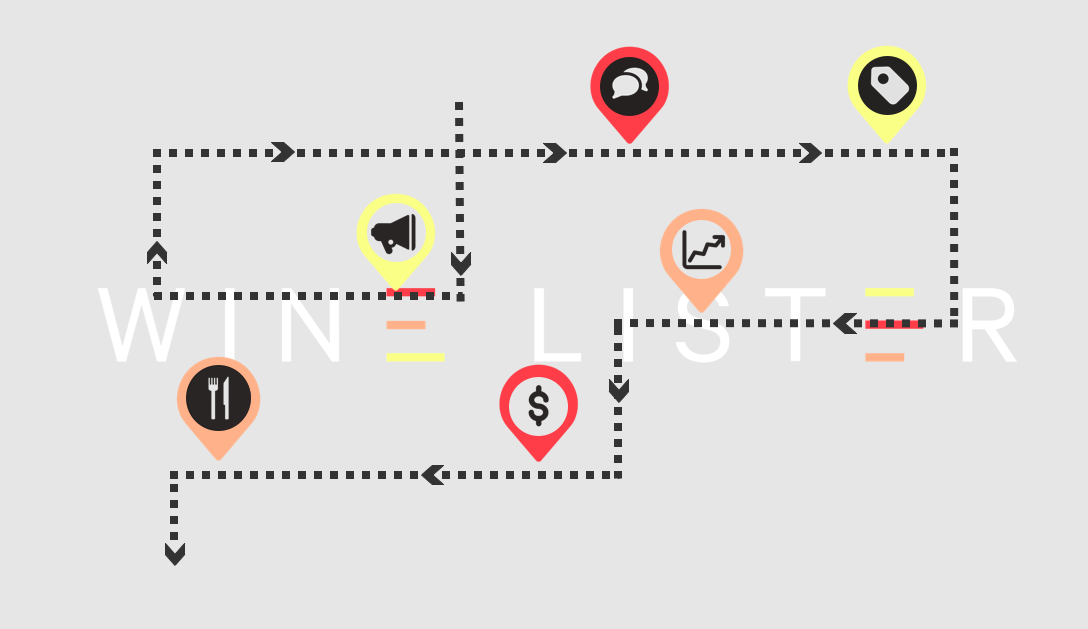
Wine Lister’s benchmarking solution relies on 14 separate data points across three areas in the life of a fine wine – Quality, Brand, and Economics – as well as qualitative trade panel feedback (through an unparalleled network from founder Ella Lister’s years as a fine wine journalist) to assess a wine’s 360° positioning in the global marketplace. Measured annually, Wine Lister’s benchmarking service enables continuous measurement of a wine within its global competitive environment, and results in a reliable, tangible reflection of progress, and ideas for the strategy path forward. Indeed, long-time Wine Lister client Don Weaver of Harlan Estate recently reflected that “It was a natural growth [to work with Wine Lister], another coming of age of our business… As we’ve matured as a business and penetrated further out into the market, we realised that we needed analytics coming back to us, and we needed best practices in our business. We can’t do everything, so we looked at Wine Lister to help us see things through different eyes.”
Such analytical rigour has resulted in numerous actionable insights for our clients, from assisting one client in increasing its journalistic coverage in a foreign market where it was underrepresented compared to peers, to a pricing strategy update for another that balanced the producer’s own interests while maintaining market confidence.
Once findings are identified, clients of Wine Lister can choose to investigate further, by supplying some of their own internal data to our analysts, enabling us to conduct deep-dives on topics as wide-ranging as customer retention, social media and communications effectiveness, or individual release price positioning. The benchmarking analysis is thus a base on which Wine Lister builds long-term relationships with its clients, helping them take their wine to the next level.
For more information, see our producer services page, or contact us for a free 30-minute consultation.
Widely considered the most romantic (if most expensive) day of the year, Valentine’s day often brings with it pressure to spend more to prove one’s admiration. To help you avoid compromise on your Valentine’s day drinking, Wine Lister has put together a list of red Value pick MUST BUYs with WL scores above 95.
Click here to view all red Value pick MUST BUYs, or read more below.
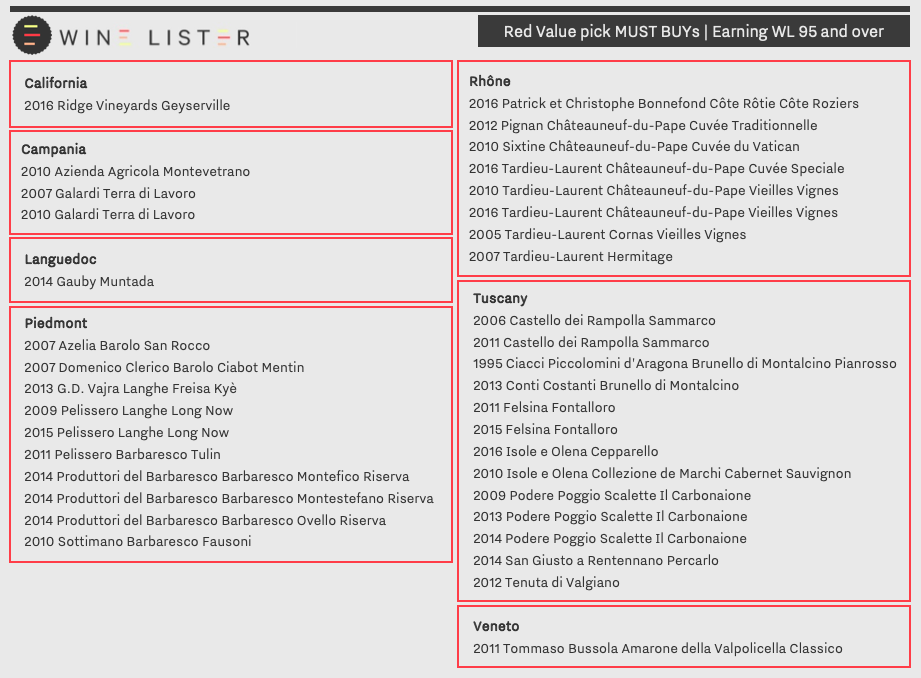
Of the 37 red Value Pick MUST BUYs earning WL 95 and over, a substantial 27 wines hail from Italy, suggesting the impressive quality-to-price ratios offered by many of the country’s producers.
A passion for Piedmont
Famed Piedmont cooperative, Produttori del Barbaresco appears three times on the list, with the 2014 vintages of its Montefico Riserva, Montestafano Riserva, and Ovello Riserva. Despite hailstorms damaging several Barbaresco vineyards in 2014, Produttori’s premium sites are subject to rigorous grape selection, meaning its single-vineyard wines retained quality in the vintage. Achieving the highest score of the three labels from Wine Lister partner critic, Antonio Galloni (96) who calls it a “potent, structured Barbaresco”, the Montefico Riserva can be purchased from Hatton & Edwards for £42 per bottle (in-bond).
Tenderness for Tuscany
Moving further south, Podere Poggio Scalette’s Il Carbonaione is represented by its 2009, 2013, and 2014 vintages, which all achieve WL scores of 95. With over 10 years of age, the 2009 is described by Wine Lister partner critic, Jancis Robinson, as offering a “very voluptuous, exotic nose”, with notes of “both herbs and spices – and some meatiness […] very exciting and bursting with health”. It can be bought from Atlas Fine Wines for £33 per bottle (in-bond).
A romance with the Rhône
Family-owned, micro-négociant, Tardieu-Laurent represents five of the eight Rhône Value picks, with its 2016 Châteauneuf-du-Pape Cuvée Speciale, 2010 Châteauneuf-du-Pape Vieilles Vignes, 2016 Châteauneuf-du-Pape Vieilles Vignes, 2005 Cornas Vieilles Vignes, and 2007 Hermitage. Despite its small-scale production (a consequence of its meticulous selection process), Tardieu-Laurent offers excellent value across its labels. Jancis Robinson awards 18 points to the 2016 Châteauneuf-du-Pape Vieilles Vignes, noting it is “very aromatic and then so sweet and round on the palate! You want to gobble it up immediately”. It can be purchased by the case of 12 from Tardieu-Laurent’s exclusive UK agent, Corney & Barrow for £390 (in-bond).
Caring for California
Representing the New World, Ridge Vineyards’ Geyserville appears in the line-up with its 2016 vintage. A single-site blend of 73% Zinfandel, 17% Carignan, 7% Petite Syrah, and 3% Alicante Bouschet, it achieves a WL score of 95, and is described by Antonio Galloni as offering “black cherry, graphite, lavender, and spice”, with “a purity […] that is absolutely striking”. Also noted by Jancis Robinson as having “snug, focused aromatics with hints of floral lift” and “a palate bursting with flavour”, the 2016 Geyserville can be acquired by the bottle from Lay & Wheeler for £33 (in-bond).
Wine Lister has put together a selection of MUST BUYs that have reached the perfect point of maturity in 2021. With a minimum score of 93, these picks take into account wines entering their apogee on the basis of Wine Lister partner critics’ drinking windows, and our own assessment of the optimum point with them, depending on region, grape variety, and style.
Read more below to discover some top wines that are at the peak of their drinking windows, or see more Wine Lister MUST BUYs here.
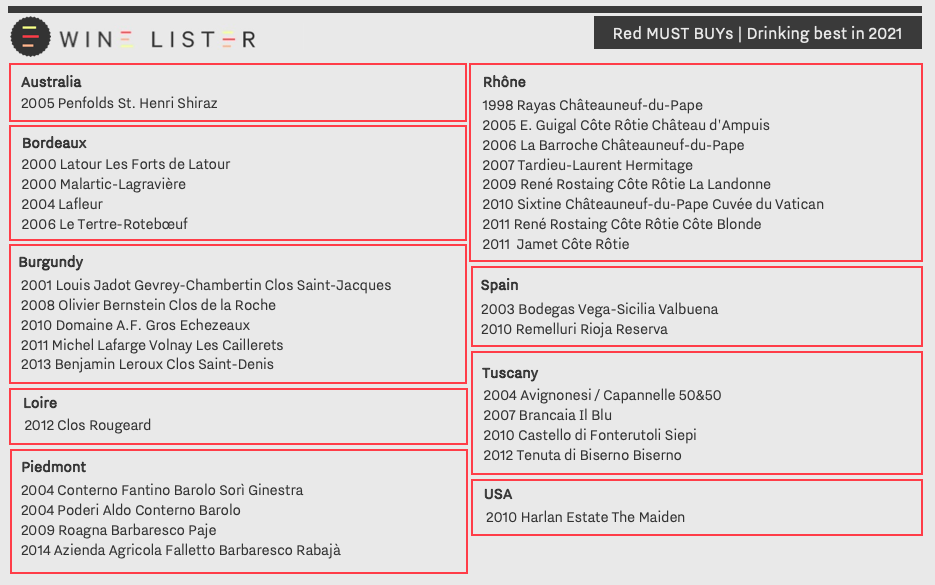
One of two Bordeaux 2000s that feature in our selection, Latour’s second wine, Les Forts de Latour aptly illustrates the success of a vintage that is widely considered one Bordeaux’s recent bests. With over 20 years of ageing under its belt, the 2000 Les Forts de Latour has a WL score of 94, and is described by Wine Lister partner critic, Jancis Robinson, as possessing a “minerality and lusciousness-yet-dryness on the finish”. With 10 more years to enjoy it, it is available to purchase from Lay & Wheeler Wine Merchants for £198 per bottle (in-bond).
In Burgundy, Michel Lafarge’s 2011 Volnay Les Caillerets is currently at the peak of its drinking window, and is noted by Jancis Robinson as offering “rich, round and charming red fruits” that “firm up on the end of the palate”. With a WL score of 94, it has four more years of optimum drinking (Jancis notes there is “lots of fun to be had”), and can be purchased from Goedhuis & Co for £95 per bottle (in-bond).
At just £28 per bottle (in-bond), the Rhône’s Château Sixtine achieves a WL score of 95 with its 2010 Cuvée du Vatican. Writing for Vinous.com (another Wine Lister partner critic outfit), Josh Raynolds describes its “explosive perfumed bouquet [that]evokes dark berry preserves, incense, licorice and candied flowers”. Currently drinking at its best, this Value Pick is worth snapping up (by the case of 12, from Bordeaux Index).
Crossing into Italy, Roagna’s 2009 Barbaresco Paje is one of four selected MUST BUYs from Piedmont that can be enjoyed at their best in 2021. “The 2009 is gorgeous. Sweet tobacco, brown spices, dried cherries, menthol and leather are some of the notes that take shape in the glass” writes our partner critic, Antonio Galloni (Vinous). The Buzz Brand is available from Bordeaux Index for £75 per bottle (in-bond).
Two New World reds feature in the selection, including Penfold’s 2005 St. Henri. The vintage saw favourable weather conditions, with particularly mild temperatures, and moderate rainfall. Available in magnum form from Cru World Wine for £144 per bottle (in-bond), it is described by Jancis Robinson as “very round, polished and gorgeous”, offering “warm, super-fruity mulberry fruit”.

Wine Lister’s selection of white MUST BUYs drinking best in 2021 includes five Burgundian picks from a range of vintages. Vincent Dauvissat’s 2012 Chablis Vaillons is a new MUST BUY, and achieves a WL score of 93. A great year for the appellation, Chablis has an average WL score of 95 across its top wines in 2012 (explore Wine Lister’s Vintage Chart here). Antonio Galloni notes that Dauvissat’s Chablis Vaillons “opens with the most exquisite, expressive aromatics imaginable. Weightless and totally gracious in the glass, […] a wine of sublime understatement”. It can be purchased from Latimer Vintners for £80 per bottle (in-bond).
View all Wine Lister MUST BUYs here, or explore our Vintage Chart to access the top wines per year.
It is the ultimate question for Burgundy fans seeking wines for drinking – with prices of the region’s best having risen so high, where can one find value?
Wine Lister’s second Burgundy study published in collaboration with regional specialist, Jasper Morris, notes the proliferation of good value wines hailing from some of the lesser-known appellations, and even outside of the Côte d’Or (Saint-Aubin, Marsannay, Mercurey, and Pouilly-Fuissé were among those mentioned).
Below Wine Lister explores some of the wines worth snapping up from the 2019 campaign*, based on their relative value when compared with other wines in their sought-after appellations. 37 out of the 58 wines listed in charts below are white.

Chablis – a permanent alternative source for Burgundy drinking white outside of the Côte de Beaune – features heavily. Buzz brands William Fèvre and Billaud-Simon achieve multiple entries, as does the Chablis estate of Maison Albert Bichot – Long-Depaquit, and relative newcomer to the cream of the crop, Jean-Paul et Benoît Droin. This group of top Chablis achieves an average price of £52 in bond per bottle, while their Côte de Beaune counterparts cost more than 30% more for the same quality (since both groups achieve an average WL score of 93).
Among the Côte de Beaune whites, Alain Chavy’s Puligny-Montrachet Folatières, and Fontainte-Gagnard’s Chassagne-Montrachet Caillerets provide the best quality-to-price ratios, both achieving WL scores of 94, for £48 and £53 per bottle in-bond respectively. Domaine Rapet’s Corton-Charlemagne provides excellent value for Grand Cru white (considering that the appellation’s reference – Jean-François Coche-Dury – typically costs over £3,000 per bottle).

Only one Grand Cru red makes the cut in top-scorers under £100 per bottle – Georges Lignier’s Clos Saint-Denis.
In the rest of the Côte de Nuits, strong value propositions hail from Taupenot-Merme throughout, particularly its Morey-Saint-Denis La Riotte. Maison Louis Jadot and Heresztyn-Mazzini achieve multiple entries in Gevrey, and the Nuits-Saint-Georges appellation makes an appearance across three producers – Grivot, Faiveley, and Henri Gouges.
The average price difference between the reds of both Côtes is not so dramatic as for Chablis and its Beaune counterparts. Côte de Beaune reds as shown the image above reach an average price of £72, just 10% lower than the Côte de Nuits group (for the same average WL score of 92). Domaine de Montille takes three of the eight places for its Corton Clos du Roi, Volnay Taillepieds, and Pommard Pézerolles.
*N.B. prices are based on those aggregated through Wine Lister’s pricing partner, Wine Owners. Not all Burgundy 2019s have recorded prices as yet, so the above lists may well evolve over the coming weeks and months.
The majority of Burgundy 2019 en primeur scores have now been published by another Wine Lister partner critic, Neal Martin (Vinous), offering further insight into the best bottles from the latest vintage.
Explore all Burgundy 2019 WL scores here, or read more below.
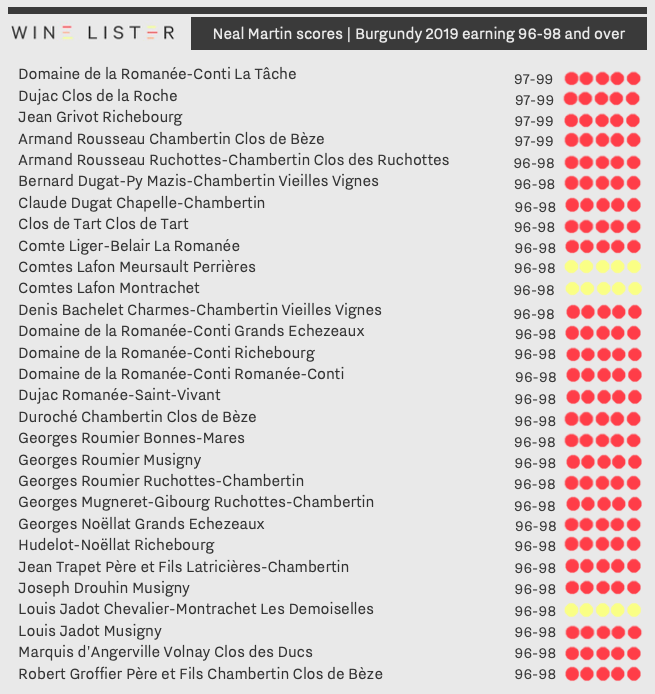
While no wines earned perfect scores this year, fittingly there are 19 Burgundy 2019s that earn 96-98 and above (compared to 15 in 2018). Domaine de la Romanée-Conti La Tâche, Dujac Clos de la Roche, Jean Grivot Richebourg, and Armand Rousseau Chambertin Clos de Bèze fare notably well with scores of 97-99.
Domaine de la Romanée-Conti occupies a further three places on the list, with its Grands Echezeaux, Richebourg, and Romanée-Conti, compared to two Domaine de la Romanée-Conti wines that appear in this score bracket in 2018.
Also scored generously by Jancis Robinson this year (recap our recent examination of her Burgundy 2019 here), Georges Roumier is awarded 96-98 for his Bonnes-Mares, Musigny, and Ruchottes-Chambertin. Featuring on both critics’ list of top-rated wines from the vintage, the Musigny is described by Neal Martin as “beautifully defined on the nose”, offering “a mixture of red and black fruit laced with blood orange, it fans out wonderfully toward the finish”.
The only white Burgundy to gain a score of 18.5 from Jancis Robinson so far, Comtes Lafon’s 2019 Montrachet is one of three whites awarded 96-98 by Neal Martin, alongside its Meursault Perrières and Louis Jadot’s Chevalier Montrachet Les Demoiselles. Members of the Wine Lister team sampled the latter at Louis Jadot’s 2019 en primeur tasting in November 2020 (recap here), and were also impressed, detecting notes of honey and brioche to complement its defined acidity.
Also featured on the list of Burgundy 2019s earning 96-96 and over from Neal Martin are: Armand Rousseau Ruchottes-Chambertin Clos des Ruchottes, Bernard Dugat-Py Mazis Chambertin Vieilles Vignes, Claude Dugat Chapelle-Chambertin, Clos de Tart Clos de Tart, Comte Liger-Belair La Romanée, Denis Bachelet Charmes-Chambertin Vieilles Vignes, Dujac Romanée-Saint-Vivant, Duroché Chambertin Clos de Bèze, Georges Mugneret-Gibourg Ruchottes-Chambertin, Georges Noëllat Grands Echezeaux, Hudelot-Noëllat Richebourg, Jean Trapet Père et Fils Latricières-Chambertin, Joseph Drouhin Musigny, Marquis d’Angerville Volnay Clos des Ducs, and Robert Groffier Père et Fils Chambertin Clos de Bèze.
Though Wine Lister are missing what would have been London’s Bourgogne tasting week this week, our partner critic, Jancis Robinson, has now released the majority of her scores for the 2019 vintage, providing a better picture of the top en primeur picks.
Explore all Burgundy 2019 scores here, or read more below.
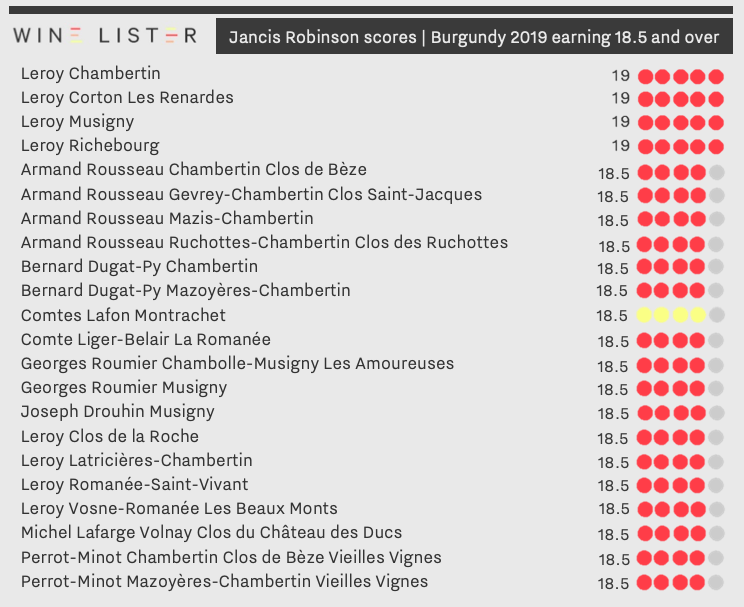
A drought year resulting in wines of extreme concentration, yet balanced by energising acidity (recap Wine Lister’s report on Burgundy’s 2019 vintage here), there are 22 Burgundy 2019s that have so far been given a score of 18.5 or above.
Jancis awarded 19 points to Leroy’s Chambertin, Corton Les Renardes, Musigny, and Richebourg, after having not published any scores for Leroy since the 2013 vintage. The property fares extremely well in 2019, occupying eight places in the list of 22 wines earning 18.5 and over. Leroy’s Clos de la Roche, Latricières-Chambertin, Romanée-Saint-Vivant, and Vosne Romanéee Les Beaux Monts all achieve a score of 18.5.
Armand Rousseau occupies four places in the list, with its Chambertin Clos de Bèze, Gevrey-Chambertin Clos Saint-Jacques, Mazis-Chambertin, and Ruchottes-Chambertin Clos des Ruchottes all earning 18.5 points. While slightly down on her ratings for the property’s 2018 offerings (she awarded 19 points to Rousseau’s Clos de la Roche and Ruchottes-Chambertin Clos des Ruchottes in 2018, and a further 18.5 points to its Chambertin, Chambertin Clos de Bèze, and Gevrey-Chambertin Clos Saint-Jacques), it nonetheless continues its excellent quality performance in 2019.
Comtes Lafon’s 2019 Montrachet is the only white Burgundy to gain a score of 18.5 from Jancis Robinson so far, continuing its series of top scores awarded by the critic in recent years. She describes it as “Both rich and savoury. Not remotely fat but with massive intensity. Throbbing and jewel-like”, concluding that “Dominique [Lafon] must be thrilled by this”.
Also featured on the list of Burgundy 2019s earning 18.5 and over from Wine Lister partner critic, Jancis Robinson are: Bernard Dugat-Py Chambertin, Bernard Dugat-Py Mazoyères-Chambertin, Comte Liger-Belair La Romanée, Georges (or Christophe) Roumier Chambolle-Musigny Les Amoureuses, Georges (or Christophe) Roumier Musigny, Joseph Drouhin Musigny, Michel Lafarge Volnay Clos du Château des Ducs, Perrot-Minot Chambertin Clos de Bèze Vieilles Vignes, and Perrot-Minot Mazoyères-Chambertin Vieilles Vignes.
View more Burgundy 2019 scores (including those of Jasper Morris and Neal Martin) here.
The end of 2020 is perhaps reason enough to pop open a bottle of champagne. With Christmas and New Year around the corner, Wine Lister has compiled a list of 21 Champagne MUST BUYs to enjoy over the last days of this year, and into 2021. Whether you have a penchant for discovering grower champagnes, or prefer to relish in those the top Grandes Maisons have to offer; whether you enjoy the purity of a Blanc de Blancs, the balance of an assemblage, or the opulence of a Blanc de Noirs, the selection of vintage champagnes below is sure to offer guidance for any preferred style.
Find out more about our 21 Champagne MUST BUYs for 2021 below.
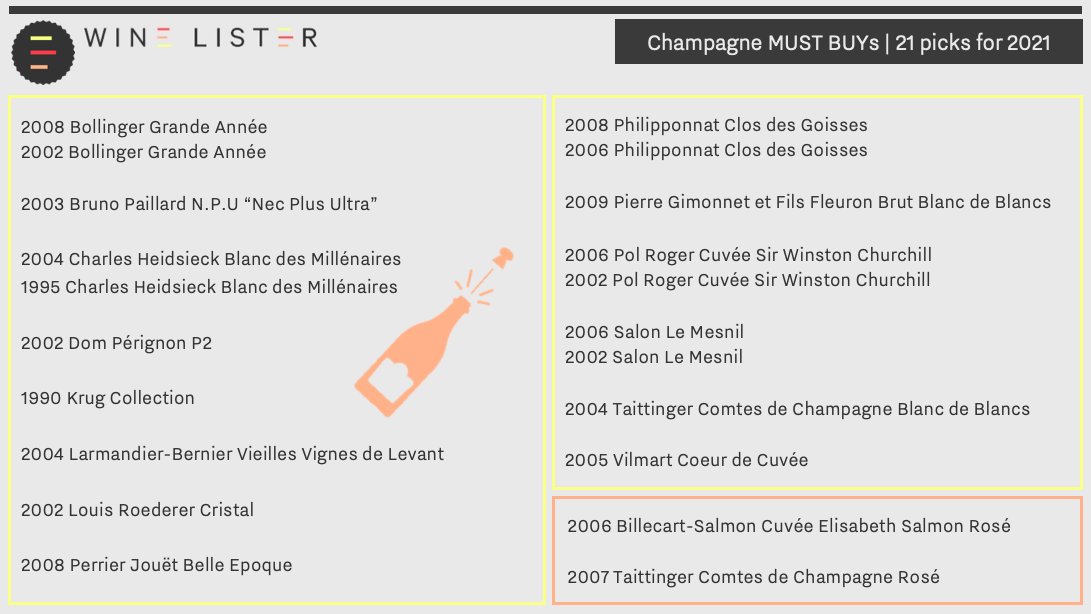
Long-established house, Charles Heidsieck, is represented in our MUST BUY selection with two vintages of its Blanc des Millénaires – 1995 and 2004. The wine is so-named to reflect its high ageing potential, and is only created in vintages worthy of the label (since its inception, just five have been made). The 2004 achieves a WL score of 95, and is praised by Wine Lister partner critic, Jancis Robinson, as having “sheer confidence, appeal and completeness”. Earning one more WL point, the 1995 shows “just how compelling this often-overlooked vintage can be”, according to Wine Lister partner critic, Antonio Galloni (Vinous). Both vintages can be bought by the case of six in-bond from Cru World Wine.
Also the crown jewel of its own house, Perrier-Jouët’s Belle Epoque carries its own portion of history within its name, referencing the Art Nouveau movement of the early 1900s. The prestige bottling can be appreciated on the inside and out, particularly in the spectacular 2008 vintage. Wine Lister tasted it recently, and found it to have a concentrated nose of white peaches, brioche, and a hint of honeysuckle, with brilliant tension on the palate. 2008 Belle Epoque is available to purchase by the bottle from Lay & Wheeler, for £129 (in-bond).
A further two MUST BUYs hail from the boutique house, Philipponnat Clos des Goisses. The 5.5-hectare Clos de Goisses parcel is the oldest and steepest “Clos” in champagne. The 2006 and 2008 vintages of this single-vineyard cuvée both receive a WL score of 96. Jancis Robinson praises both vintages, writing that the 2006 “positively screams for attention”, while the 2008 is “explosive… like a firework on the palate”. They can both be acquired in-bond from Bordeaux Index.
Included in our 21 MUST BUY champagnes are two grower offerings lying outside of champagne’s more widely-declared vintages. Notorious for its killer heatwave, 2003 is not well-appreciated among the champenois. Bruno Paillard’s 2003 N.P.U. challenges this perception, offering a “dancing” palette of “open and floral notes” according to Jancis Robinson. Acknowledging that the vintage was hugely criticised, Paillard says that for him, “it’s a great vintage”. Another elusive grower champagne rounds off our list. Jancis Robinson hailed the 2005 Vilmart Coeur de Cuvée as “a wine to wallow in”, praising its complexity and “refreshing finish”.
Also featured in the list of 21 Champagne MUST BUYs for 2021 are: 2006 Billecart-Salmon Cuvée Elisabeth Salmon Rosé, 2008 Bollinger Grande Année, 2002 Bollinger Grande Année, 2002 Dom Pérignon P2, 1990 Krug Collection, 2004 Larmandier-Bernier Vieilles Vignes de Levant, 2000 Louis Roederer Cristal, 2009 Pierre Gimonnet et Fils Fleuron Brut Blanc de Blancs, 2006 Pol Roger Cuvée Sir Winston Churchill, 2002 Pol Roger Cuvée Sir Winston Churchill, 2006 Salon Le Mesnil, 2002 Salon Le Mesnil, 2004 Taittinger Comtes de Champagne Blanc de Blancs, and 2007 Taittinger Comtes de Champagne Rosé
As 2020 draws to a close, Wine Lister has compiled a report celebrating the top-performing wines and producers within a series of categories over the past year. Using our axes of Quality, Brand, and Economics, and the several factors that constitute these values, we have created seven leagues that paint a panoramic view of some of the world’s best wines, ranked within their areas of excellence.
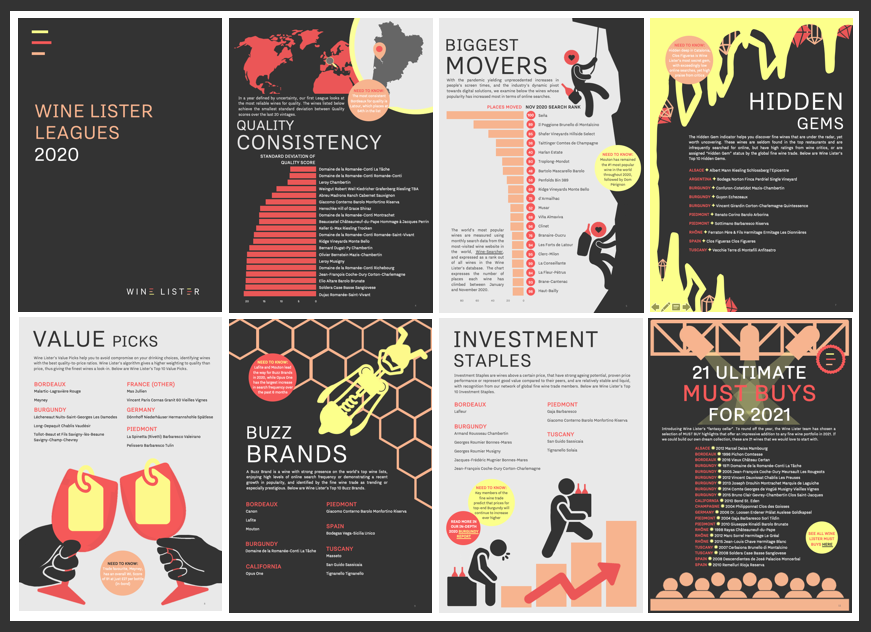
Wine Lister’s 2020 Leagues include rankings of Quality Consistency (wines that show the smallest standard deviation between Quality scores over the last 20 vintages), and Biggest Movers (wines whose popularity has increased most in terms of online searches over the past year). Our team has also put together its top-10 wines per Wine Lister Indicator, revealing our recommendations for Hidden Gems, Value Picks, Buzz Brands, and Investment Staples.
We end the Leagues with a list of 21 Ultimate MUST BUYs for 2021, compiling a selection of MUST BUY highlights hand-picked by our fine wine experts, that offer an impressive addition to any fine wine portfolio in 2021. These are some of the picks that would feature in Wine Lister’s “fantasy cellar”.
Download your free copy of Wine Lister’s 2020 Leagues here.
If ever there is a time for claret, it’s Christmas. While Bordeaux generally provides excellent quality for its prices relative to other regions all year round, it is an especially good source for festive bottles with a bit of age. Below Wine Lister offers one MUST BUY under £100 per Bordeaux appellation – a selection that promises to please with your Christmas meal.
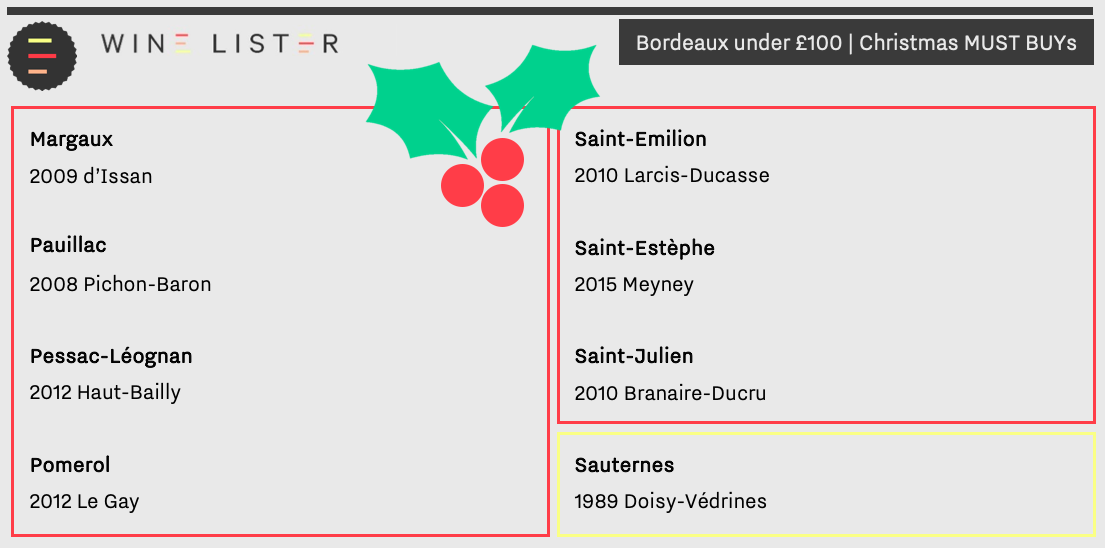
Aside from its lustrous gold label providing an appropriate centrepiece to any festive feast, d’Issan 2009 offers good value for its appellation, earning a WL score of 93 at £56 per bottle (in-bond). Château owner, Emmanuel Cruse, is also the “Grand Maître” of the Commanderie du Bontemps – a Bordeaux organisation uniting trade members in the preservation of Bordeaux’s excellent quality reputation. D’Issan embodies the values of its maker, exemplifying the traditional claret style with added Margaux elegance. It is available to purchase by the case of 12 from Nickolls and Perks.
Pauillac powerhouse Pichon-Baron 2008 is described by Wine Lister partner critic, Neal Martin (Vinous), as one of the property’s “overachievers in recent years”. Often noted for being one of the most concentrated wines of the vintage in its appellation and beyond, Martin writes that the 2008 is “full of tension and energy […] delivering real brightness and vivacity on the finish”. At £90 per bottle (in-bond), it is the most expensive wine featured in this article, however, its Second Growth status and an abundance of critics’ praise make it worthy of consideration. Pichon-Baron 2008 can be acquired by the case from Lay & Wheeler.
A top-quality substitute to some of Haut-Bailly’s more costly back vintages, the 2012 achieves the property’s second-best WL score ever, as well as second place for quality among Pessac-Léognan reds for the vintage. Wine Lister partner critic, Antonio Galloni (Vinous), states that “the decision to lower temperatures in fermentation and go for a soft, gentle extraction, along with strict selection has paid off big time” in 2012, revealing notes of “dark raspberries, mint, crushed flowers, spices and rose petals”. Haut-Bailly 2012 is just entering its drinking window, and can be bought from Cru Wine.
Finding value on Bordeaux’s right bank can be trickier, particularly in Pomerol. Le Gay 2012 nonetheless offers excellent quality (WL 94) for the relatively reasonable price of £61 per bottle (in-bond). Wine Lister partner critic, Jancis Robinson, notes that it reaps “real Pomerol reward in terms of concentration”, offering a “very well-integrated nose […] sweet and focused”. In neighbouring Saint-Emilion, Larcis-Ducasse 2010 is described as “simply stunning” by Antonio Galloni, who notes “violet, lavender, graphite and menthol” that “give the 2010 its energy and tension”. It gains a WL score of 94, at £87 per bottle (in-bond). Both of these right bank picks can be purchased from Cult Wines.
Achieving Value Pick status, Saint-Estèphe’s Meyney 2015 has a WL score of 93 at £25 per bottle (in-bond), providing a veritable steal for your Christmas meal. After sampling at the annual Southwold Bordeaux tasting, Neal Martin writes that it “was the shock of this blind tasting – in a positive sense […] I thought it might be Montrose but it turned out to be Meyney. Chapeau!” Though the 2015 could benefit from a few more years of ageing, it is a brilliant gift option for your more patient guests, and can be acquired from Goedhuis & Co.
Saint-Julien star, Branaire-Ducru’s 2010 vintage was described as “dancing” by Jancis Robinson. Neal Martin’s tasting note suggests a wine of complexity: “a lovely mélange of red and black fruit, hints of dried blood and autumn leaves suggesting that this is moving into its secondary phase”. With a WL score of 93, Branaire-Ducru 2010 can be purchased by the case of 12 from Farr Vintners for £52.50 per bottle (in-bond).
For a sweet end to your Christmas meal, Wine Lister suggests Doisy-Védrines 1989. With 30 years of ageing under its belt, it achieves a WL score of 94 – the château’s highest ever. It is described by Neal Martin as boasting “a captivating bouquet of gorgeous wild honey, Seville orange marmalade, fig jam and light lemongrass scents”. He adds, “it is simply everything you desire in a sweet Bordeaux”. Purchase Doisy-Védrines 1989 by the bottle from Hedonism Wines for £62.80 (in-bond).
The first of the Burgundy 2019 en primeur releases began this month, reigniting conversation of last year’s growing season, and its subsequent offerings. Wine Lister has spoken to several key Burgundy producers, and has sampled the 2019s from leading négociant, Louis Jadot, to get a better picture of this promising vintage.
Burgundy’s 2019 growing season was marked by a notably hot and dry summer, resulting in wines of extreme concentration. Due to a combination of spring frost, uneven flowering, and summer drought across many sites, yields in 2019 are significantly lower than average.
 A line-up from Louis Jadot’s 2019 en primeur tasting, organised by Hatch Mansfield at Vagabond, Monument on the 3rd of November 2020
A line-up from Louis Jadot’s 2019 en primeur tasting, organised by Hatch Mansfield at Vagabond, Monument on the 3rd of November 2020
Sourcing grapes from across the region, including its own holdings in some of Burgundy’s most prized plots (e.g. Chapelle Chambertin, Clos Vougeot, and Vosne-Romanée), Louis Jadot’s production in 2019 is down 50% for Chardonnay, and 30% for Pinot Noir. A cool and windy spring caused millerandage across Jadot’s sites, leading to many of the smaller, unripe berries being discarded. Warm temperatures in 2019 meant that grapes had high natural sugar levels, and correspondingly high alcohol across the region. Deputy General Manager, Thibault Gagey, tells us that several Louis Jadot wines are approaching 14 degrees in 2019, however, they nonetheless offer “good acidity, so they are powerful but balanced”, and there “isn’t a feeling of high alcohol”.
Wine Lister agrees whole-heartedly, and was particularly impressed by the quality of the whites. The Chablis Blanchot was “pure and lithe with an already-sumptuous texture”, while the Chassagne Montrachet Morgeot Clos de la Chapelle offered a delightful nose of “honey, truffle, and brioche”, with “rich citrus” on the palate. For reds, Wine Lister enjoyed the “complex and earth-toned” Clos Saint-Denis, and the “powerful but poised” Gevrey-Chambertin Clos Saint-Jacques. Gagey informs us that he is indeed “very proud of the 2019s”, and is “confident that it will be a good vintage”.
Across the Côte de Beaune, harvests were small in 2019. Arnaud Ente tells us that his namesake domaine saw “a spell of spring frost”, which caused significant damage and loss of yield, and “uneven weather patterns during flowering”, caused coulure and millerandage. The summer was mostly hot and dry, causing hydraulic stress to the vines, but “20-30mm of rainfall in late August” helped to unblock phenolic maturation, and allow the grapes to reach “impressive levels of maturity while maintaining good sugar levels, and also a very lovely acidity”. Ente notes that his 2019s have achieved “extraordinary balance, due to the acidity in the grapes developing slowly”. The vintage is of “enormous potential”, if down 20% on an average year in terms of volume.
Domaine Jean-Noël Gagnard similarly experienced significant frost in 2019; the principal cause of its small harvest. Winemaker Caroline Lestimé echoes the experience of “millerandage followed by hydraulic stress on the vines during the summer drought”, resulting in “small, but thankfully exceedingly concentrated berries”. Due to the two extremes of conditions throughout the season, Lestimé analysed the sugar / acid balance frequently near to harvest, so as to pick the optimum window for picking. Once again, quality here is likely a triumph, but Lestimé adds that “Jean-Noël Gagnard has not seen such a small harvest since 1999”.
Guillaume d’Angerville tells us that in Volnay, “frost risk was on everyone’s mind”, however, “dry and windy conditions helped to avoid frost damage” across Marquis d’Angerville’s plots. Water and heat stress in summer was a problem here too, “stopping the plant’s evolution, and veraison was delayed as a result”. He similarly explains that “selecting the correct harvest date proved difficult”, in part due to the “heterogenous grape maturation”, however in the end, “the entire range benefitted from the perfect maturity of the grapes”, despite yields being down 20-30% on the average year. He tells us that his 2019s are “succulent and full of energy”, without being “jammy” from such a hot year, and therefore providing “another successful vintage ending in 9”.
Akin to Louis Jadot, Winemaker Jean-Nicolas Méo tells us that Méo-Camuzet’s 2019s are “well-ripened”, with “fairly high alcohol levels, around 14 degrees”. He states that there is nonetheless “a nice acidity to start”, which provides the wines “a good freshness and a certain structure”, as well as lengthy ageing capacity. Echoing d’Angerville’s sentiment on the success of 9s, Méo foresees “an evolution of this vintage like the 2009: rich and greedy at first, then gradually closing, to emerge in a decade more tense and structured than suggested today”.
Despite the significantly reduced volumes in 2019, the quality of Burgundy’s latest vintage release clearly suggests a long and promising future ahead. The combination of these two factors will surely see demand outweigh supply for en primeur once again. For more guidance on buying Burgundy 2019 en primeur, and essential analysis to inform your wider Burgundy investment decisions, purchase our in-depth Burgundy study here.











